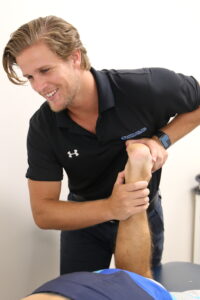Manual therapy, a major part of physiotherapy, utilises hands-on techniques to help alleviate pain, improve mobility, and foster better body function. Therapists apply pressure and specific movements on muscles and joints, aiding in relief from discomfort caused by muscular tension and joint dysfunctions. Techniques include mobilisation, manipulation, and soft tissue work, each serving a unique purpose in managing musculoskeletal conditions. The main aim of this guide is to provide a comprehensive understanding of what manual therapy is, its diverse applications, and how it enhances your overall well-being.

The History of Manual Therapy
The history of manual therapy goes back a long way, finding its origins in ancient civilisations where touch was a central aspect of healing. These societies recognised the power of tactile therapy in providing relief and restoring function. Over time, the science has evolved, blending traditional techniques with a growing understanding of human anatomy, physiology, and pathology.
Now, it stands as an integral part of modern physiotherapy, practised widely in Australia and across the globe. The practice blends historical ideas with contemporary evidence-based knowledge, continuing the tradition of touch-based healing in a scientific context.
Different Types of Manual Therapy Techniques
Manual therapy techniques are diverse and tailored to fit each patient’s specific needs. Soft tissue work, for instance, is designed to address muscle tension and promote relaxation. Joint mobilisation and manipulation techniques strive to enhance joint mobility, while manual lymphatic drainage techniques are geared towards reducing swelling. There are many examples of other manual therapy techniques such as Muscle Energy, ART, Mulligans Principles, Kaltenborn Mobilisation and movement assisted joint mobility techniques. Rarely are any of these used in isolation.
The physiotherapist’s role involves choosing the appropriate technique based on a careful assessment of the patient’s condition, treatment goals, and responsiveness to treatment. So, while the term “manual therapy” is quite broad, an experienced physiotherapist will generally offer a wide range of treatment options, adjustable to cater to every individual’s unique health needs and circumstances. There are many examples of other manual therapy techniques such as Maitland style Joint mobilisation and manipulation, Muscle Energy, ART, Mulligans Principles, Kaltenborn Mobilisation and movement assisted joint mobility techniques. Rarely are any of these used in isolation. As mentioned above, an experienced Manual Physiotherapist will often use a variety of these methods during one treatment session.
The Science Behind Manual Therapy
Manual therapy operates on scientific principles rooted in our understanding of the body’s anatomy and physiology. It stimulates the body’s natural healing processes, improves blood circulation, reduces inflammation, and alters pain perception. For example, manipulation techniques may improve joint mobility, while massage can increase blood flow, aiding the removal of waste products from tissues and promoting relaxation.
In addition, there is a belief that this treatment may also affect pain signals sent to the brain, contributing to overall pain reduction. By understanding the science underpinning manual therapy, we can appreciate its role in fostering recovery and promoting wellness.
Many conditions occur due to imbalances and asymmetry of muscles and bony structures within the body, in particular the hips, pelvis, knees, shoulders, neck, back areas just to name a few. Exercise alone is often not enough to address these imbalances, although exercise remains an integral part of assisting the process to help maintain more adequate alignment ongoing.
How Manual Therapy Works in Physiotherapy
Manual therapy, integral to physiotherapy, works in conjunction with other forms of treatment. It’s used with exercise, education, and advice, delivering a comprehensive treatment plan tailored to the patient’s needs. While exercises strengthen and condition the body, manual therapy addresses immediate pain and mobility issues, and education provides self-management tools.
Together, these elements create a comprehensive plan to maximise recovery and prevent future injuries. It’s essential to understand that while this form of treatment has significant standalone benefits, it always works best as part of a multi-faceted physiotherapy program.
How a Manual Therapy Session Works
A manual therapy session typically starts with a comprehensive assessment, including a review of your medical history and a physical examination. Your physiotherapist then formulates a custom treatment plan, applying manual therapy techniques that align with your specific condition and objectives. A session might involve soft tissue work, joint mobilisation, manipulation, or a combination of techniques.
A good Manual Therapist will constantly re-evaluate the effectiveness of the applied techniques throughout the treatment session. Post-treatment, your physiotherapist will also further review your response to the treatment, modifying the plan as necessary for future sessions. Communicating openly with your therapist throughout this process is essential for the most effective results. This overview gives you an insight into what to expect when you choose manual therapy.
The Benefits of Manual Therapy
In the world of physiotherapy, manual therapy has proven effective in addressing various musculoskeletal conditions. It is widely known to reduce pain, improve mobility and enhance overall function in cases of back pain, neck pain, and other orthopaedic conditions. Patients often report immediate relief following treatment, with improved ability to perform daily tasks.
Additionally, manual therapy may speed up recovery by getting rid of metabolic waste and enhancing blood flow to affected areas. It’s worth noting that, while beneficial, manual therapy should never be seen as a fix-all solution. Always use it in conjunction with other treatments.

Are There Risks or Side Effects of Manual Therapy?
Manual therapy carries risks and potential side effects like all therapeutic treatments. These might include temporary discomfort during or after treatment, slight dizziness, or short-term fatigue. Importantly, the likelihood of experiencing these effects largely depends on the individual’s health status, the technique used, and the therapist’s skill and experience.
In skilled hands, manual therapy is generally safe and side effects, if they occur, are typically mild and short-lived. As always, open communication with your therapist about any concerns or unusual reactions is essential in ensuring a safe, effective treatment process.
Who Can Benefit from Manual Therapy?
Manual therapy is a versatile treatment option with potential benefits for a wide range of individuals. People with sports injuries, chronic pain conditions, and those in recovery post-surgery can often benefit from it. It’s also useful in managing occupational injuries or conditions related to age or lifestyle, like back pain from long periods of sitting.
It’s worth noting, though, that as every individual’s situation is unique, the appropriateness and effectiveness of any therapy depend on a thorough assessment by a qualified professional. Therefore, if you’re considering manual therapy, it’s essential to seek advice from a trusted physiotherapist.
Finding a Qualified Manual Therapist
Choosing the right manual therapist is crucial to ensuring effective treatment. Look for professionals with recognised qualifications in physiotherapy, and additional training and experience in manual therapy. Australian Physiotherapy Association membership can be a reliable indicator of professional standing. Don’t hesitate to ask about their experience, approach to treatment, and any other questions that might affect your comfort and trust.
It’s also important to consider practical factors such as location, availability, and cost. Lastly, a good therapist should make you feel heard, respected, and comfortable throughout the process, fostering a therapeutic relationship that supports your healing journey.
At MGS Physiotherapy, we’re dedicated to offering personalised manual therapy treatments designed for your unique needs. To discover the benefits of manual therapy, please contact us today for further information or make an appointment today.
CALL NOW TO BOOK YOUR APPOINTMENT
